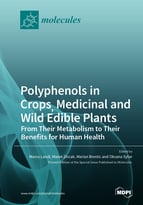Polyphenols in Crops, Medicinal and Wild Edible Plants: From Their Metabolism to Their Benefits for Human Health
A special issue of Molecules (ISSN 1420-3049). This special issue belongs to the section "Medicinal Chemistry".
Deadline for manuscript submissions: closed (31 October 2019) | Viewed by 79104
Special Issue Editors
Interests: plant breeding & genetics; biochemistry; cell signaling; metabolomics; transcriptomics
Special Issues, Collections and Topics in MDPI journals
Interests: plant stress physiology; abiotic stress; photosynthesis; crop physiology; chlorophyll fluorescence; non-invasive methods; plant phenotyping
Special Issues, Collections and Topics in MDPI journals
Interests: secondary metabolites; phenolics; novel compounds; applied research
Special Issues, Collections and Topics in MDPI journals
Interests: abiotic stresses; fruit quality; plant nutrition; plant allometry; tree physiology; secondary metabolism; tree species
Special Issues, Collections and Topics in MDPI journals
Special Issue Information
Dear Colleagues,
Phenolic compounds from crops, medicinal herbs, and wild edible species, including phenolic acids, coumarins, flavonoids, and tannins, may play a crucial role in the prophylaxis of various human diseases. The antioxidant capacity of polyphenols, likely their key prerogative in controlling a plethora of human diseases, varies, sensibly depending on their chemical nature, whose complexity has paralleled the evolution of land plants. The aim of this Special Issue is: (i) to describe polyphenols’ classification, diversification, and occurrence in the plant kingdom, (ii) to report the effect of climate change on their metabolisms, (iii) to establish the potential benefits of polyphenols for human pathologies, testing their antioxidant activity with the attempt to exploit the derived secondary metabolites as drug or nutraceutical compounds in fortified foods. This Special Issue is particularly devoted to studies related to medicinal herbs of different ethnobotanical regions, with the attempt to discover plant resources that can be used for the extraction of targeting polyphenols, leading to the development of new medicaments for treating especially complicated and minor diseases. The plant kingdom is indeed an open-pit mine of chemical compounds which are still waiting to be explored, a task that can be accomplished in the era of “omic” sciences. Special focus is on medicinal herbs of different ethnobotanical regions, with the biochemical characterisation and specification of their antioxidant, anticarcinogenic, anti-inflammatory, etc., potential for the development of medicinal chemical drugs or as nutritional components in functional foods.
Prof. Dr. Marian Brestic
Dr. Marek Zivcak
Dr. Oksana Sytar
Dr. Marco Landi
Guest Editors
Manuscript Submission Information
Manuscripts should be submitted online at www.mdpi.com by registering and logging in to this website. Once you are registered, click here to go to the submission form. Manuscripts can be submitted until the deadline. All submissions that pass pre-check are peer-reviewed. Accepted papers will be published continuously in the journal (as soon as accepted) and will be listed together on the special issue website. Research articles, review articles as well as short communications are invited. For planned papers, a title and short abstract (about 100 words) can be sent to the Editorial Office for announcement on this website.
Submitted manuscripts should not have been published previously, nor be under consideration for publication elsewhere (except conference proceedings papers). All manuscripts are thoroughly refereed through a single-blind peer-review process. A guide for authors and other relevant information for submission of manuscripts is available on the Instructions for Authors page. Molecules is an international peer-reviewed open access semimonthly journal published by MDPI.
Please visit the Instructions for Authors page before submitting a manuscript. The Article Processing Charge (APC) for publication in this open access journal is 2700 CHF (Swiss Francs). Submitted papers should be well formatted and use good English. Authors may use MDPI's English editing service prior to publication or during author revisions.
Keywords
- phenolic acids
- coumarins
- anthocyanins
- flavonoids
- catechins
- tannins










